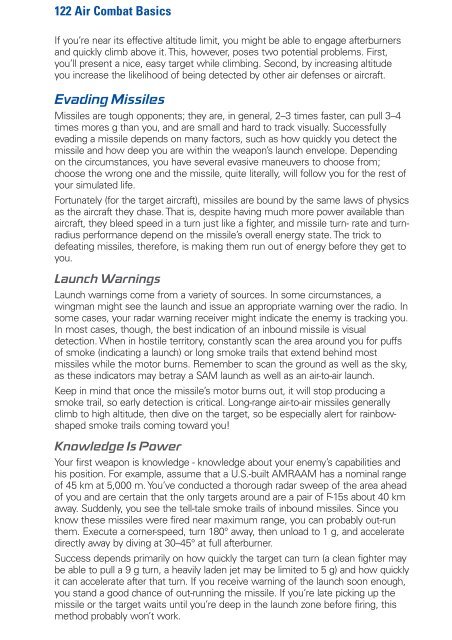Heads-Up Display Modes 35 - Metaboli
Heads-Up Display Modes 35 - Metaboli
Heads-Up Display Modes 35 - Metaboli
Create successful ePaper yourself
Turn your PDF publications into a flip-book with our unique Google optimized e-Paper software.
122 Air Combat Basics<br />
If you’re near its effective altitude limit, you might be able to engage afterburners<br />
and quickly climb above it. This, however, poses two potential problems. First,<br />
you’ll present a nice, easy target while climbing. Second, by increasing altitude<br />
you increase the likelihood of being detected by other air defenses or aircraft.<br />
Evading Missiles<br />
Missiles are tough opponents; they are, in general, 2–3 times faster, can pull 3–4<br />
times mores g than you, and are small and hard to track visually. Successfully<br />
evading a missile depends on many factors, such as how quickly you detect the<br />
missile and how deep you are within the weapon’s launch envelope. Depending<br />
on the circumstances, you have several evasive maneuvers to choose from;<br />
choose the wrong one and the missile, quite literally, will follow you for the rest of<br />
your simulated life.<br />
Fortunately (for the target aircraft), missiles are bound by the same laws of physics<br />
as the aircraft they chase. That is, despite having much more power available than<br />
aircraft, they bleed speed in a turn just like a fighter, and missile turn- rate and turnradius<br />
performance depend on the missile’s overall energy state. The trick to<br />
defeating missiles, therefore, is making them run out of energy before they get to<br />
you.<br />
Launch Warnings<br />
Launch warnings come from a variety of sources. In some circumstances, a<br />
wingman might see the launch and issue an appropriate warning over the radio. In<br />
some cases, your radar warning receiver might indicate the enemy is tracking you.<br />
In most cases, though, the best indication of an inbound missile is visual<br />
detection. When in hostile territory, constantly scan the area around you for puffs<br />
of smoke (indicating a launch) or long smoke trails that extend behind most<br />
missiles while the motor burns. Remember to scan the ground as well as the sky,<br />
as these indicators may betray a SAM launch as well as an air-to-air launch.<br />
Keep in mind that once the missile’s motor burns out, it will stop producing a<br />
smoke trail, so early detection is critical. Long-range air-to-air missiles generally<br />
climb to high altitude, then dive on the target, so be especially alert for rainbowshaped<br />
smoke trails coming toward you!<br />
Knowledge Is Power<br />
Your first weapon is knowledge - knowledge about your enemy’s capabilities and<br />
his position. For example, assume that a U.S.-built AMRAAM has a nominal range<br />
of 45 km at 5,000 m. You’ve conducted a thorough radar sweep of the area ahead<br />
of you and are certain that the only targets around are a pair of F-15s about 40 km<br />
away. Suddenly, you see the tell-tale smoke trails of inbound missiles. Since you<br />
know these missiles were fired near maximum range, you can probably out-run<br />
them. Execute a corner-speed, turn 180° away, then unload to 1 g, and accelerate<br />
directly away by diving at 30–45° at full afterburner.<br />
Success depends primarily on how quickly the target can turn (a clean fighter may<br />
be able to pull a 9 g turn, a heavily laden jet may be limited to 5 g) and how quickly<br />
it can accelerate after that turn. If you receive warning of the launch soon enough,<br />
you stand a good chance of out-running the missile. If you’re late picking up the<br />
missile or the target waits until you’re deep in the launch zone before firing, this<br />
method probably won’t work.















